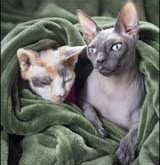Pet Tips
Hairless Cats – Pet tip 145

For many, just the thought of a hairless cat is enough to make them shudder. For these people, the sight of a hairless cat is shocking, and touching one is downright scary. If you are one of these people, then this article is unlikely to sway you in the other direction. However, if you are the kind of person who has always been a little bit intrigued by the unique look of hairless cats, read on. Behind their striking appearance is a fascinating background, and if you are considering making a hairless cat part of your family, there is also a plethora of information to know about the proper way to care for these beautiful creatures.
Congenital hairlessness in cats is an extremely rare trait. Essentially, a hairless cat is the result of genetic mutations in one or more of the genes which encode for normal hair development. While the word ‘mutation’ implies that this genetic condition is unwanted and accidental, there are actually many breeders who select specifically for the hairlessness trait and work to maintain the hairless lineage in their cats.
One example of a cat breed that is based on hairlessness is the Canadian Sphynx. This breed, which initially arose in Toronto in 1966 has become one of the most famous hairless cat breeds in the world. Sphynx kittens may be born entirely bald, or with an initial downy coat. Upon their first shed however, further hair growth ceases. The only areas where fur might be found is on the ears, muzzle, tail, and sometimes feet.
In addition to their obvious lack of hair, there are several other features that are commonly seen in the Sphynx and other hairless-based breeds. Some of these cats have abnormal whiskers, nails, and dentition. Most also have markedly enlarged sebaceous (oil) glands and defective tear ducts. All of these characteristics mean that hairless cats require special attention and care beyond that of the average feline pet.
Without a fur coat, hairless cats have a difficult time maintaining their core temperature. In order to keep warm, hairless cats seem to have developed a high metabolic rate. This means that they require high quality food and lots of it to meet their daily energy demands and create the heat they require. It is also important that these cats remain indoors as their skin is at great risk of both burning and freezing in extreme weather conditions. They are also more prone to insect bites than cats with fur might be. Some owners living in cooler climates will find it necessary to provide their hairless cats with a coat or blanket at certain times, even when indoors.
The lack of fur and increased number of sebaceous glands also causes oil to build up quickly on the skin of these special cats. It is critical that owners make a point of bathing their hairless cat at least once a week to keep them free of oil and dirt build-up. If this routine is started at a young age, most cats will not mind the process at all. It is also usually necessary to clean their ears and around their eyes more often than might be necessary for an average cat. In general, the lack of hair puts these cats in a higher risk category for infections, so owners must be observant and diligent when it comes to providing their pets with both at-home and veterinary care.
Due to all these extra demands, hairless cats are not for everybody. Their appearance is not to everyone’s taste, and no one can deny their high-maintenance lifestyle. But for the committed owner, hairless cats can make wonderful long-term companions. With proper care they can live healthy long lives, averaging at about 15 years of cuddly, hairless fun.
By Alison Norwich – Pets.ca writer
